1857-1949
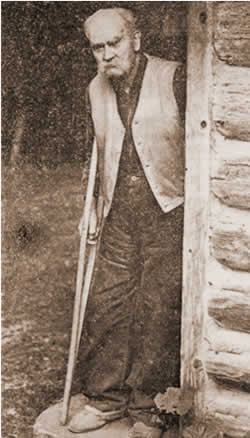
Charles H. Anway, 1940s.
Charles H. Anway was born on 1 May, 1857 in Ionia County, Michigan to Mr. and Mrs. Harvey Anway. He joined his brother John who was born 3 years earlier. The boys attended school until Charles was in about the third grade. Their parents decided to move to new mining areas in the Colorado Territory. They traveled by covered wagon into the new territory. Henry decided to start a roadhouse, which he called the Colorado House. It was said to be one day’s horseback ride from Cherry Creek mining camp, which later became Denver.
His mother did the cooking for the roadhouse and kept a large garden to supply vegetables for the table. Charles helped his mother with her garden tasks. He had a great affection for his mother. As he grew older he learned to hunt and soon was bringing game in to the roadhouse to supply meat for the table.
At the age of 14, he decided to leave home and strike out for himself as a game hunter for the many mining camps in the area. The friction between he and his father added to the early departure. For most of the next 30 years he wandered around the tri-state area, meat hunting, gold panning, and exploring. He only worked for someone when he was in desperate need of money. Once he was working on an irrigation project and was very interested in the level and transit. When the project was finished, the water failed to flow as desired. The engineer left the project in a huff. The owner of the project was desperate, so when Anway suggested that he thought he could finish the project right, the owner hired him. He hand made his own instruments and soon had the water flowing as it should have the first time. After that he did local survey jobs. Later he surveyed his homestead in Haines, and when an engineer checked this survey for the patent, he found it to be perfect.
News of gold in Alaska began to circulate through the country, so Anway and a friend decided to go. They departed in late June 1898 on the Topeka and arrived in Skagway on 2 July 1898. His friend was having second thoughts, as he missed his wife and child. He finally decided he could not go any further. He and Anway sold all of their packhorses, food, and mining equipment. His friend had enough money to return to his family in Colorado, while Anway, who decided to stay, had no equipment and could not go to Dawson.
Charlie decided to go down to Pyramid Harbor, near Haines. There he met Jack Dalton, who offered Charlie a job taking a packtrain of horses to the Yukon River where the goods could be trans-shipped to Dawson. This was a great opportunity for Anway to see the country so he would have a better idea where he would like to prospect. As he passed through the Porcupine mining district, he was very impressed. After delivering the goods to a ship on the Yukon, Anway returned with the horses to Pyramid Harbor. He then returned to the Porcupine district and began prospecting. All the good sites on the lower river were already staked, so he went up to the headwaters of Porcupine Creek and staked a few claims. He then crossed over the mountain and explored Nugget Creek, staking out several more claims. These seemed to be his better claims, so he built a cabin on Nugget Creek as home base for all his claims.
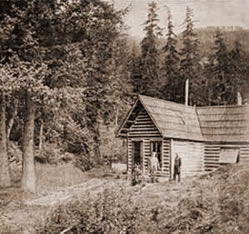
The Anway Cabin, early 1900s.
During the winter months, he and other miners moved into Haines since they were unable to work their claims. Anway explored the country and eventually found a place he decided would make a good homestead. On Dec 17, 1901, he walked about a mile out of town to this area and staked out his homestead. He immediately began clearing land and getting logs for his cabin. In March, he once again loaded his Yukon Sled and began the long trip to Nugget Creek.
That fall he received an offer for his claims on Nugget and Porcupine Creeks. He accepted the offer, so that he now had a grubsteak for the time needed to start his farm. He needed to clear more land and build his cabin. He decided to have a fruit farm and strawberries would be the main crop. In 1905, he decided to add apples and ordered apple trees that were hardy in North Dakota.
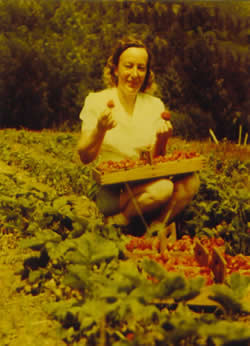
Mary Meacock holding two Anway strawberries and a flat of strawberries from Anway’s feild, circa 1950.
A big turning point in Charlie’s life occurred in April of 1913, when Henry Vermiere and his young family arrived to homestead near his place. Charlie took the children under his wing and helped them as they and the family grew. All of the children worked for Anway, where they earned money for school clothes and other necessities. He always made sure they had toys for Christmas. Since he never married, this became his family and some of the children remained with or near him the rest of his life.
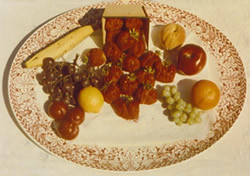
Anway strawberries were huge, averaging 12-15 berries per quart. The largest berries measured 7 inches in circumference.
Strawberries were the first crop that Anway grew. He got his start from Jack Dalton’s garden at Porcupine. Dalton told him that he got the berry from a man named Dixon about twenty years before. This strawberry is without a rival in size or quality and it does well almost everywhere in the valley, as the climate and soil seem well suited for the plant. During the picking season, Anway would hire as many as 20 women and girls. Pickers were paid 5 cents per box, and they could often earn five dollars a day picking as many as 150 crates. The crates sold for $4.50 each so he was grossing about $720 per day. He continued this for about 25 years, shipping berries to Skagway, then north on the train, and also shipping to Juneau when ships were available. Haines became known as the Strawberry Capital of Alaska. In the 1909 Alaska-Yukon-Pacific Exposition in Seattle, Anway won a certificate of honor for his “strawberries in glass.”
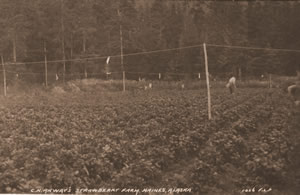
Anway strawberry fields.
The apple orchard he started soon began to produce apples, but did not really produce large crops until he imported honeybees. They not only pollinated the apples, but supplied him with honey. He sold apples and apple cider. In the 1915 September Skagway Horticulture Fair, he won an award for “the exhibit of the first mature apple in Alaska.” He certainly had the first commercial apple orchard in Alaska. Many of his trees lived long after he was gone, although the last ones appear to be dying (1998).
Strawberry farming is very intensive so by 1930 Charlie was looking for easier farming and settled on a sweet cherry orchard. For the next 25 years, Charlie supplied all the sweet cherries the community could consume. To my knowledge, this is the first and only sweet cherry orchard in Alaska. In the late ’50s the whole orchard died from a fungus.
Charlie did other farming as well. He raised milk goats, mink, and rabbits. He grew potatoes commercially. He tried raspberries. He continued to experiment to make a better product. He developed an early pink skinned potato which he called the Early Anway. He also did a lot of work trying to develop an early corn that could be raised here, although in this project he failed.
Anway was an excellent craftsman. He could make anything with his hands, and his building, furniture, and tools were always done with excellence. He was well liked by everyone and was said to have had no enemies. Some of his admirers have said “they don’t make them like that anymore.”
Charlie became sick in December of 1949, and was air lifted to the hospital in Juneau where he died on 14 December 1949. He was interred in Juneau’s Evergreen Cemetery. His obituaries called him Alaska’s “Johnny Appleseed” and the “Strawberry King of Alaska”. The community of Haines held an annual “Strawberry Festival” in his honor for many years.
Bob Henderson, 1997.
Charlie Anway Cabin Preservation & Restoration Project
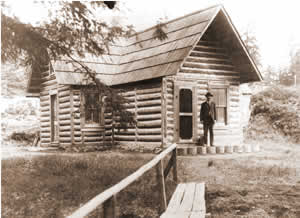
The Anway Cabin with Charlie at the front door, 1910.
The Chilkat Valley Historical Society is working toward restoring the Anway Cabin to its former glory! Learn more!
